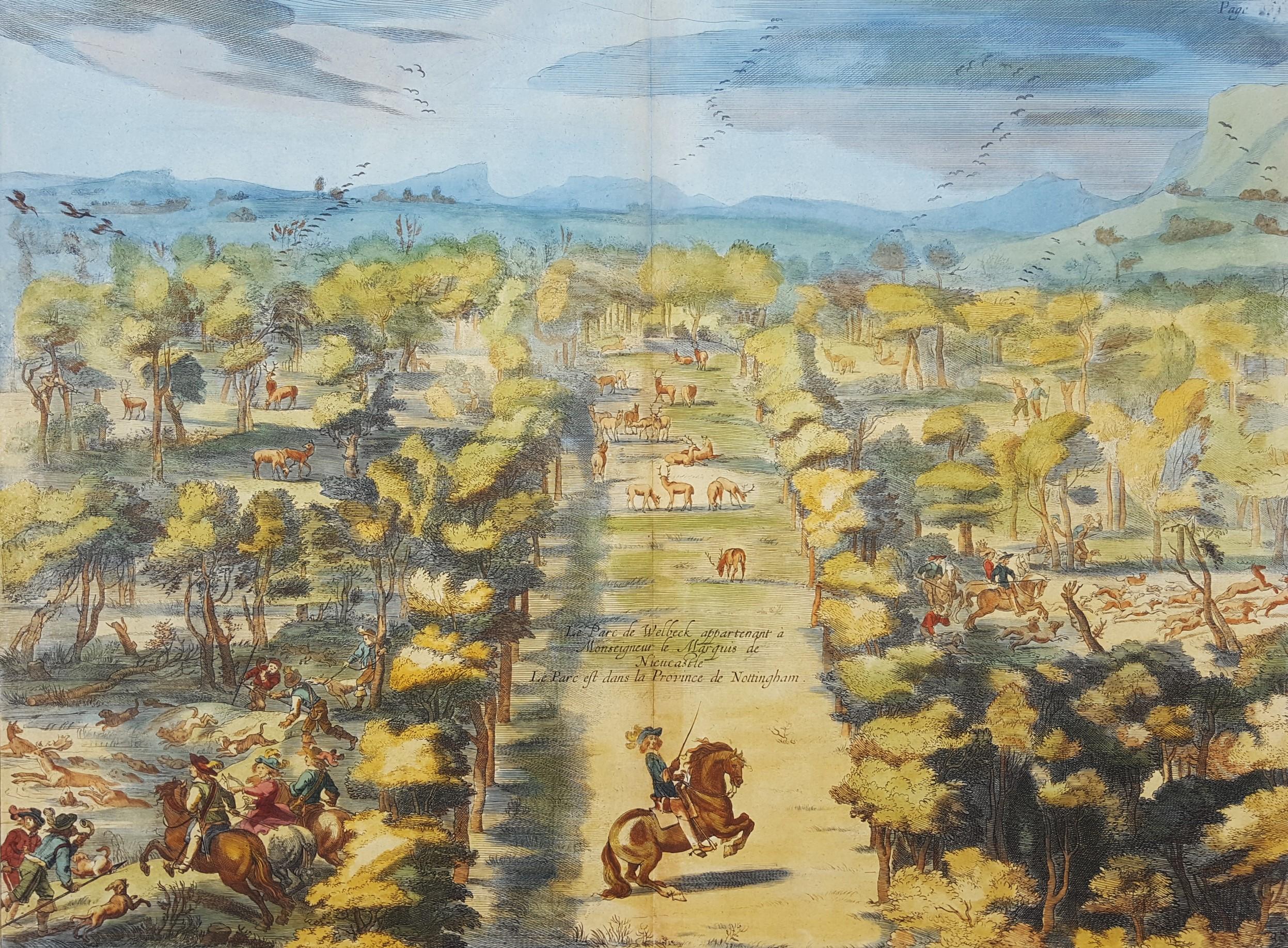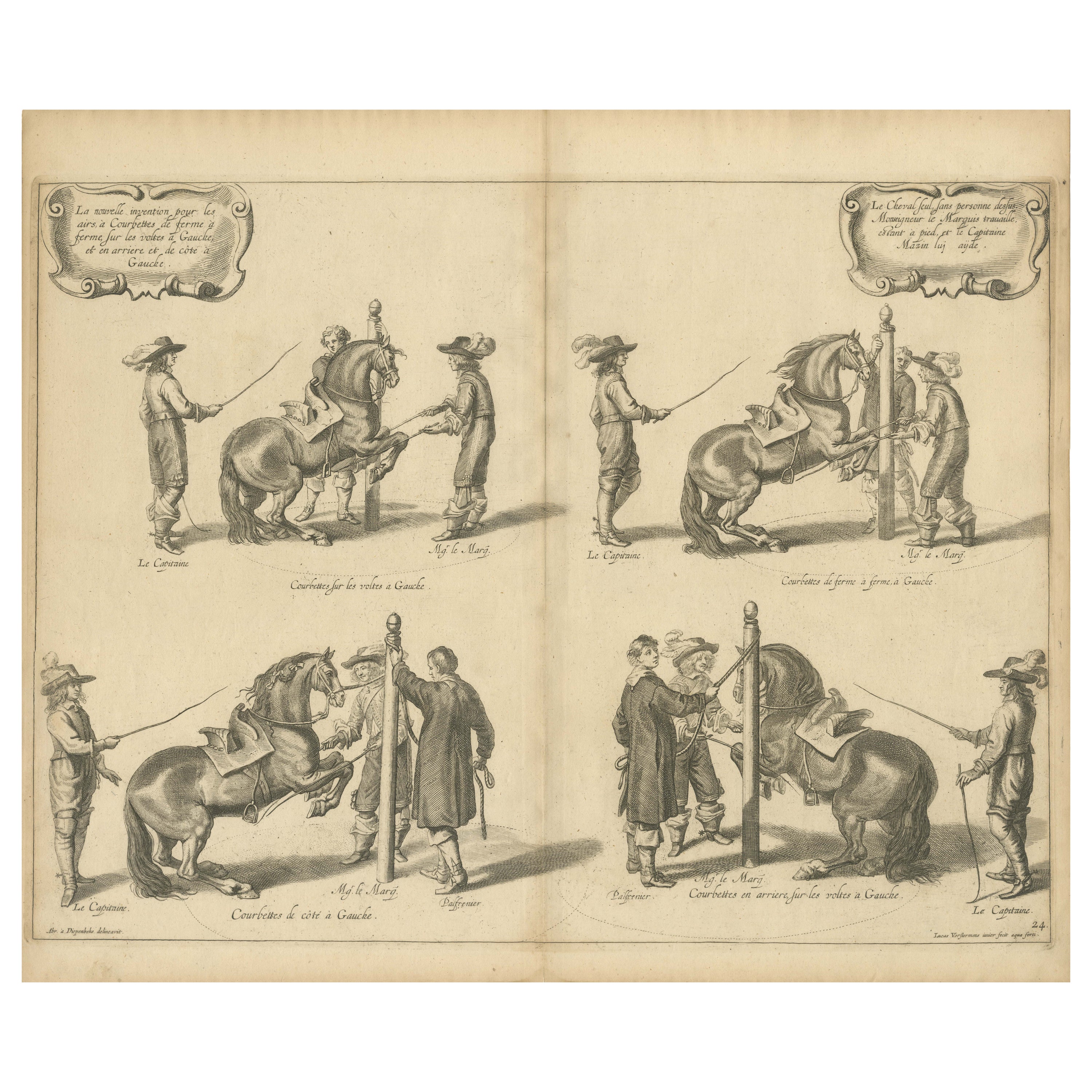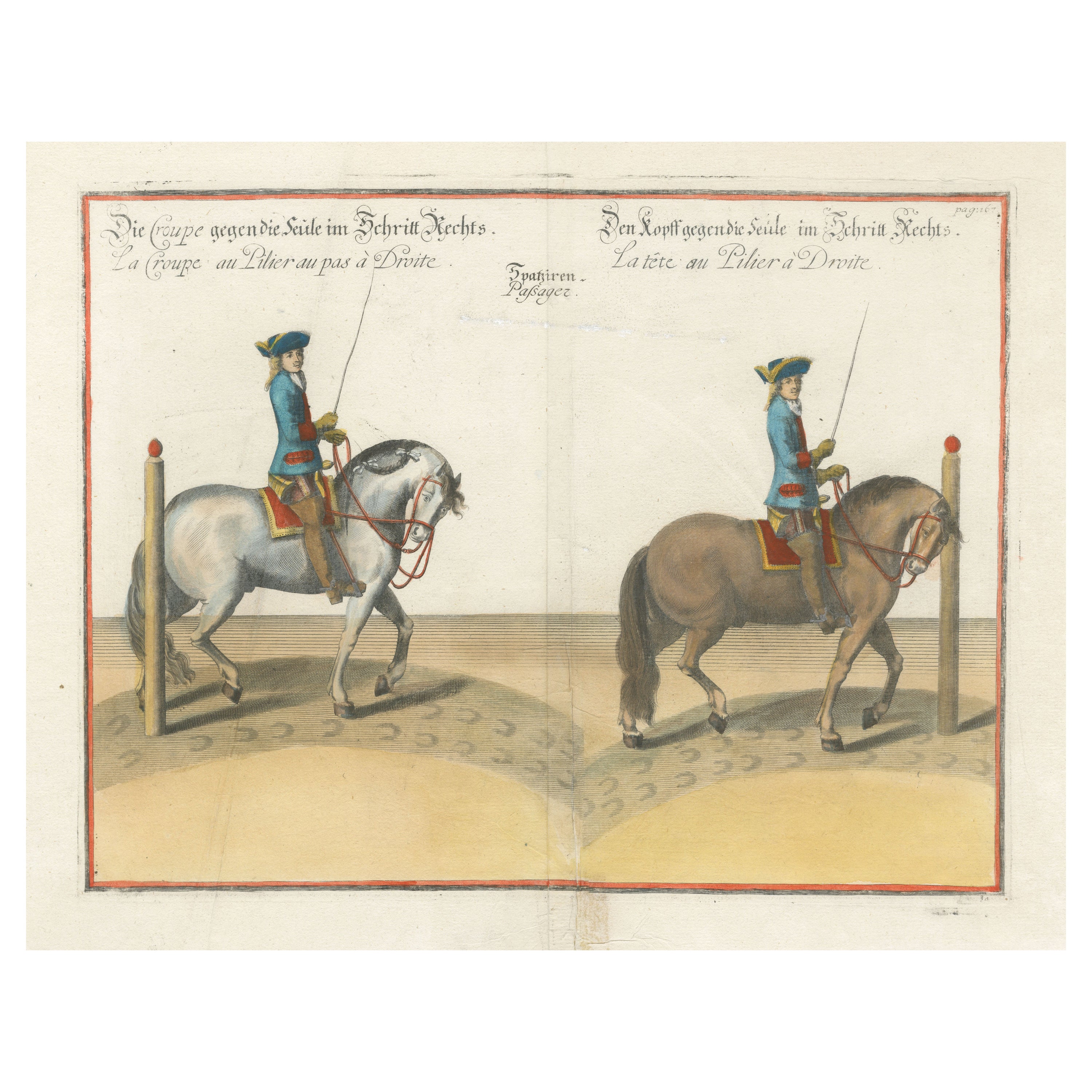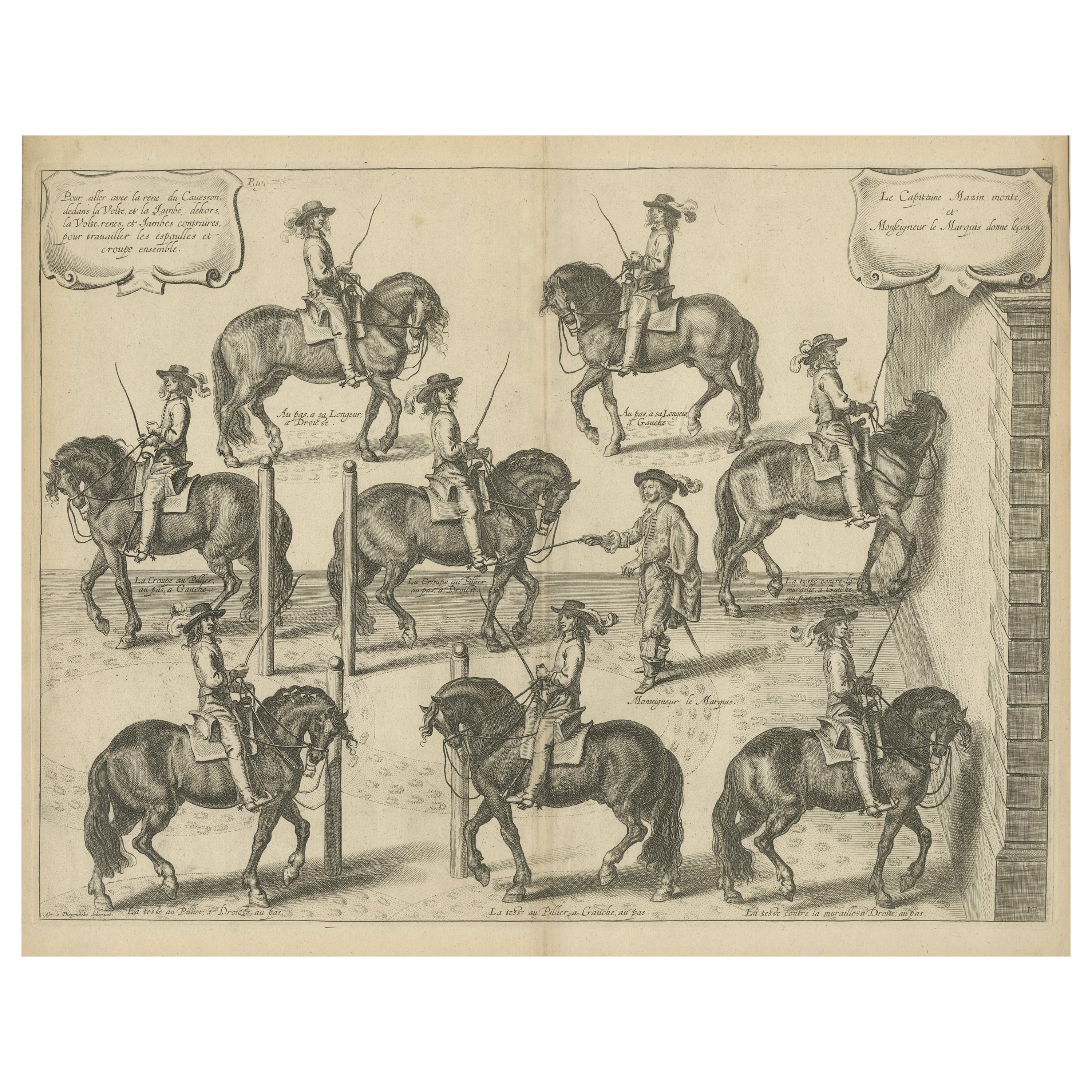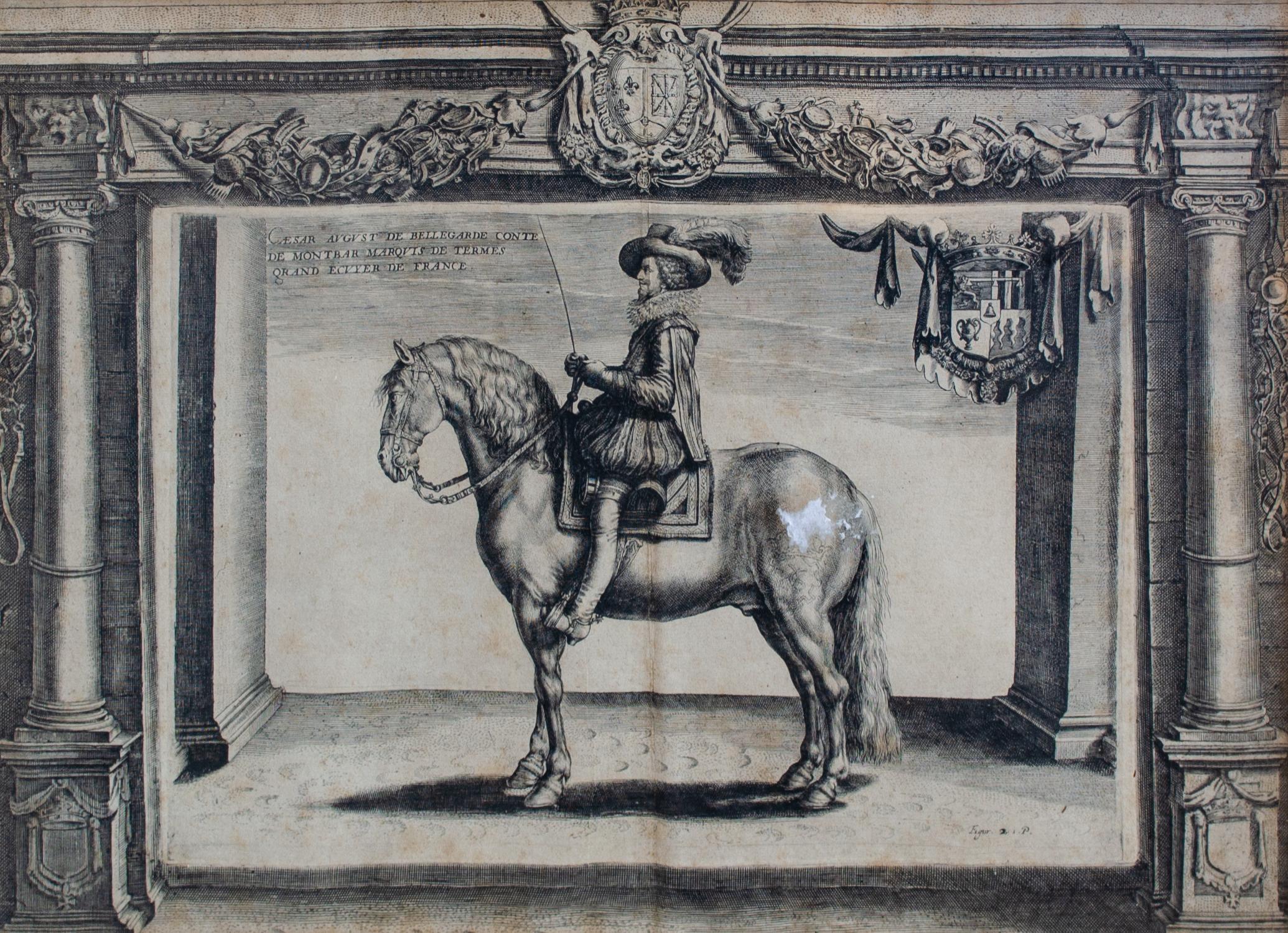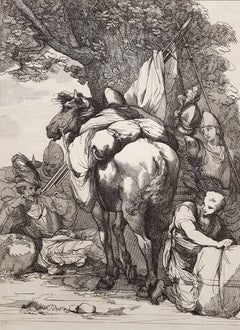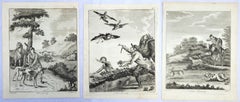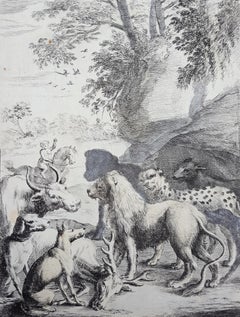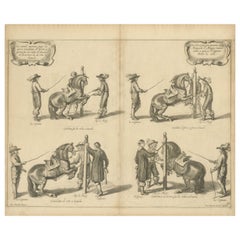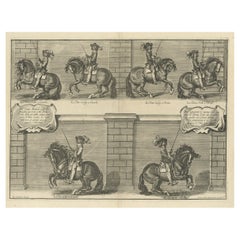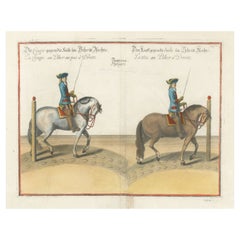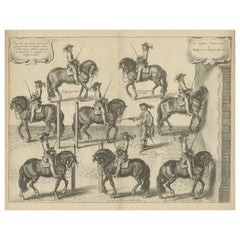Items Similar to Captain Mazin Rides, and the Marquis Gives the Lesson /// Equestrian Horse Art
Want more images or videos?
Request additional images or videos from the seller
1 of 19
William CavendishCaptain Mazin Rides, and the Marquis Gives the Lesson /// Equestrian Horse Art1737
1737
$1,200
£890.45
€1,037.25
CA$1,670.41
A$1,860.15
CHF 968.11
MX$22,935.43
NOK 12,329.57
SEK 11,588.60
DKK 7,739.16
Shipping
Retrieving quote...The 1stDibs Promise:
Authenticity Guarantee,
Money-Back Guarantee,
24-Hour Cancellation
About the Item
Artist: William Cavendish (English, 1593-1676)
Title: "Captain Mazin Rides, and the Marquis Gives the Lesson" (Plate 17, Page 76)
Portfolio: Methode et Invention Nouvelle de Dresser Les Chevaux (New Method and Invention of Dressing Horses)
Year: 1737 (Second edition)
Medium: Original Hand-Colored Engraving and Etching on Strasbourg Bend laid paper
Limited edition: Unknown
Printer: Jean Brindley, London, UK
Publisher: Jean Brindley, London, UK
Reference: Brunet I, 1699; Graesse II:93; Lowndes VI:1663; Mellon/Podeschi 26, page 34-35; Mennessier de la Lance II, page 246-247; Nissen ZBI 848; Huth page 21
Sheet size: 16.5" x 22.5"
Image size: 15.07" x 20"
Condition: UV stain and toning to sheet. One small tear lower right in margins. Has been professionally stored away for decades. It is otherwise a strong impression in good condition
Notes:
Provenance: private collection - Cheltenham, UK. With overlapping centerfold as issued. Engraved by an unknown Dutch artist (Active: Mid 17th Century) after a drawing by Dutch artist Abraham van Diepenbeeck (1596-1675). This particular plate, 17, is the only plate from its portfolio that does not specify an engraver's name. Comes from Cavendish's one volume "Methode et Invention Nouvelle de Dresser Les Chevaux", (1737) (Second edition), which consists of 42 double-paged engravings. Printed in one color from one copper plate: black. There is a Strasbourg Bend watermark with "L R? B" in the center of the left sheet and an unidentified watermark resembling a "V" in the center of the right sheet.
The 1657-1658 (First edition) of "Methode et Invention Nouvelle de Dresser Les Chevaux" was printed and published by Jacques Van Meurs in Antwerp, Belgium in two issues, 1657 and 1658. It consists of 42 double-paged copperplate engravings executed by Dutch artists Pieter de Jode II or (the Younger) (1606-1674), Pieter Clouwet (1629-1670), Pieter van Lisebetten (1630-1678), Cornelis Van Caukercken (1626-1680), Lucas Vorsterman II (1624-c.1666), Adriaen Lommelin (1620-1673), and Theodor van Kessel (1620-1696) after drawings by Dutch artist Abraham van Diepenbeeck (1596-1675). "This first printing was largely destroyed by fire in the bookseller’s shop, and is all but impossible to acquire." - Brunet. The 1737 (Second edition) of "Methode et Invention Nouvelle de Dresser Les Chevaux" was the first to be published in England using the same original 42 copperplates and 50 woodcut text diagrams from 1658, acquired by printer/publisher Jean Brindley in London, UK.
"The Duke of Newcastle, a staunch royalist went into exile to Antwerp in 1644. Newcastle had bought a pair of Barbary horses in Paris and set up a stable for training his horses. Translated from his manuscript in English, it illustrates the riding school which, in spite of the loss of a vast fortune in England during the Civil War, he managed to build up at Antwerp where he was residing as an exile from the Commonwealth. Although showered with honors by Charles II at the Restoration, he retired to his estates in Derbyshire and devoted himself to literature, the breeding of horses and equitation. His manége near Bolsover still exists. This work, partly paid for by his friend Sir Hugh Cartwright, is a celebration of Dukes' horses and their training. The plates include five equestrian portraits, four of the author; five plates of his own horses; and 24 scenes showing horses being trained (most featuring the Duke, Captain Mazin and occasionally, a groom named Palfrenier). There are also two allegorical designs, in which the Duke is adored by a circle of reverential horses, and at the end a portrait of the Cavendish family." - Christie's, New York
Biography:
William Cavendish, 1st Duke of Newcastle upon Tyne, KG, KB, PC (c. 16 December 1593 – 25 December 1676), who after 1665 styled himself as Prince William Cavendish, was an English courtier and supporter of the arts. He was a renowned horse breeder, as well as being patron of the playwright Ben Jonson and the intellectual group known as the Welbeck Circle. Despite spending the then enormous sum of £15,000 entertaining Charles I in 1634, he failed to gain a significant political post. In the early stages of the First English Civil War, he was appointed Royalist Captain-General in Northern England; he financed much of the war effort himself, later claiming this totaled in excess of £1,000,000. After the defeat at Marston Moor in July 1644, a battle fought against his advice, he went into exile in Europe. He returned to England after the Stuart Restoration in 1660, and although created Duke of Newcastle in 1665, he remained on the fringes of the court and became critical of Charles II. He died in 1676 and was buried in Westminster Abbey.
- Creator:William Cavendish (1593 - 1676, English)
- Creation Year:1737
- Dimensions:Height: 16.5 in (41.91 cm)Width: 22.5 in (57.15 cm)
- Medium:
- Movement & Style:
- Period:1730-1739
- Condition:
- Gallery Location:Saint Augustine, FL
- Reference Number:1stDibs: LU121214984382
About the Seller
5.0
Platinum Seller
Premium sellers with a 4.7+ rating and 24-hour response times
Established in 1978
1stDibs seller since 2015
1,323 sales on 1stDibs
Typical response time: <1 hour
- ShippingRetrieving quote...Shipping from: Saint Augustine, FL
- Return Policy
Authenticity Guarantee
In the unlikely event there’s an issue with an item’s authenticity, contact us within 1 year for a full refund. DetailsMoney-Back Guarantee
If your item is not as described, is damaged in transit, or does not arrive, contact us within 7 days for a full refund. Details24-Hour Cancellation
You have a 24-hour grace period in which to reconsider your purchase, with no questions asked.Vetted Professional Sellers
Our world-class sellers must adhere to strict standards for service and quality, maintaining the integrity of our listings.Price-Match Guarantee
If you find that a seller listed the same item for a lower price elsewhere, we’ll match it.Trusted Global Delivery
Our best-in-class carrier network provides specialized shipping options worldwide, including custom delivery.More From This Seller
View AllWelbeck Park Belongs to the Marquis of Newcastle /// Equestrian Horse Old Master
By William Cavendish
Located in Saint Augustine, FL
Artist: William Cavendish (English, 1593-1676)
Title: "Welbeck Park Belongs to the Marquis of Newcastle" (Plate 38, Page 263)
Portfolio: Methode et Invention Nouvelle de Dresser Les Chevaux (New Method and Invention of Dressing Horses)
Year: 1737 (Second edition)
Medium: Original Hand-Colored Engraving and Etching on watermarked laid paper
Limited edition: Unknown
Printer: Jean Brindley, London, UK
Publisher: Jean Brindley, London, UK
Reference: Brunet I, 1699; Graesse II:93; Lowndes VI:1663; Mellon/Podeschi 26, page 34-35; Mennessier de la Lance II, page 246-247; Nissen ZBI 848; Huth page 21
Sheet size: 17" x 21.25"
Image size: 15" x 20"
Condition: Toning to sheet and some edgewear in right margins. Centerfold is separated at very top and bottom in margins. It is otherwise a strong impression in good condition with strong colors
Notes:
With overlapping centerfold as issued. Engraved by Dutch artist Theodor van Kessel (1620-1696) after a drawing by Dutch artist Abraham van Diepenbeeck...
Category
1730s Old Masters Animal Prints
Materials
Watercolor, Laid Paper, Engraving, Intaglio, Etching
Packhorse and Soldiers /// Antique British Victorian Etching Figurative Animal
By John Hamilton Mortimer
Located in Saint Augustine, FL
Artist: (after) John Hamilton Mortimer (English, 1740-1779)
Title: "Packhorse and Soldier"
Year: 1783
Medium: Original Etching on watermarked laid paper
Limited edition: Unknown
Prin...
Category
1780s Pre-Raphaelite Animal Prints
Materials
Etching, Laid Paper, Intaglio
Set of Three Engravings from "The British Sportsman" /// Osbaldiston Animal Art
Located in Saint Augustine, FL
Artist: William Augustus Osbaldiston (English, Active: Late 18th Century)
Titles: "Coursing" (Plate 3), "Hawking" (Plate 7), and "Hare Hunting" (Plate 8)
Portfolio: The British Sport...
Category
1790s English School Animal Prints
Materials
Laid Paper, Engraving, Intaglio
Het leeuwendeel (The Lion's Share) /// Old Masters Animals Landscape Dog Leopard
By Dirk Stoop
Located in Saint Augustine, FL
Artist: Dirk Stoop (Dutch, c.1615-1686)
Title: "Het leeuwendeel (The Lion's Share)"
Portfolio: The Fables of Aesop
Year: 1665 (an earlier state of unknown states)
Medium: Original Et...
Category
1660s Old Masters Animal Prints
Materials
Etching, Laid Paper, Intaglio, Gesso
William the Conqueror Giving a Charter to his Nephew Alan Earl of Britain
Located in Saint Augustine, FL
Artist: Francis Drake (English, 1696-1771)
Title: "William the Conqueror Giving a Charter to his Nephew Alan Earl of Britain" (Plate 12)
Portfolio: Eboracum: or The History and Antiquities of the City of York
Year: 1736 (First edition)
Medium: Original Engraving on watermarked light laid paper
Limited edition: Unknown
Printer: William Bowyer...
Category
1730s Old Masters Figurative Prints
Materials
Laid Paper, Engraving
Draught of a Galley /// Old Masters Ship Boat Seascape Construction Diagram Art
By William Henry Toms
Located in Saint Augustine, FL
Artist: William Henry Toms (English, c.1700-1765)
Title: "Draught of a Galley" (Plate 13, Vol. III, page 131)
Portfolio: La Spectacle de la Nature
Year: 1737
Medium: Original Hand-Colored Engraving on laid paper
Limited edition: Unknown
Printer: Unknown, London, UK
Publisher: Humphreys, London, UK
Framing: Recently framed in a Regency style gold moulding with 100% cotton rag matting and 99% UV protective Museum Glass. The frame is an antique frame we've reused, originally built by Knoedler Gallery, New York, NY
Framed size: 10.25" x 10.25"
Sheet size (irregular margins): 6.63" x 8.25"
Image size: 4.75" x 6.75"
Condition: In excellent condition with strong colors and good margins
Rare
Notes:
Comes from the 1737 volume edition of Noël-Antoine Pluche's "La Spectacle de la Nature", translated from the original French by Humphreys as "Nature Displayed". With two soft vertical folds within paper as issued. Various dealer reference numbers and an old price pencil inscribed in margins and on verso.
Biography:
William Henry Toms (c. 1700–1765) was an English engraver. He worked on portraits, book-plates, landscapes and prints of buildings. Among his works were the plates for Robert West's "Perspective Views of All the Ancient Churches in London" (1736–1739). In 1741, he worked with Thomas Badeslade on "Chorographia Britanniae or a New Set of Maps of all the Counties in England and Wales". The maps were republished on 29 September 1742, with additional place names. Among Toms's apprentices was the engraver and publisher John Boydell. W. H. Toms lived in Masham Street, London, and was the father of the painter Peter Toms. Toms died in 1765.
Noël-Antoine Pluche (1688-1761) , known as the abbé Pluche, was a French priest...
Category
1730s Baroque More Prints
Materials
Watercolor, Laid Paper, Engraving, Intaglio
You May Also Like
Equestrian Engravings of Cavendish's General System of Horsemanship, 1743
Located in Langweer, NL
Plate 24 from "A General System of Horsemanship in All Its Branches," (La Methode et Invention nouvelle de Dresser les Chevaux). William Cavendish Duke of Newcastle's work on equestr...
Category
Antique 1740s Prints
Materials
Paper
$828 Sale Price
20% Off
Free Shipping
Rare Antique Print of the Schooling of Horses in the Early 18th Century, ca.1740
Located in Langweer, NL
Antique horse print titled 'La Vraije Methode (..)'.
Antique print depicting the schooling of horses. This print originates from 'Methode et Invention Nouvelle de Dresser les Che...
Category
Antique 1740s Prints
Materials
Paper
$712 Sale Price
20% Off
Original Antique Horse Riding Print with Hand Coloring
Located in Langweer, NL
Antique print titled 'La croupe au Pilier au pas à Droite (..)'. This print originates from 'Des Welt-berühmten Herzog Wilhelms von Newcastle Neu-eröffnete Reit-Bahn. Welche erstlich...
Category
Antique Early 18th Century Prints
Materials
Paper
$343 Sale Price
25% Off
Original Antique Engraving: Duke of Newcastle Instructing Horse Dressage, 1743
Located in Langweer, NL
Plate 17 from "La Methode et Invention nouvelle de Dresser les Chevaux" portrays William Cavendish, the first Duke of Newcastle, providing instructions to Captain Mazin in the art of...
Category
Antique 1740s Prints
Materials
Paper
$828 Sale Price
20% Off
Free Shipping
The Earl of Montbar, famous French horseman, Crispin de Passe Engraving
By Crispin De Passe
Located in New York, NY
Crispin van de Passe The Younger (c. 1594-1670)
Caesar August de Bellegarde Conte de Montbar Marquis de Termes grand Ecuyer de France, c. 1660
Engraving
Sight: 11 3/4 x 15 3/4 in.
Fr...
Category
17th Century Old Masters Portrait Prints
Materials
Engraving
Collection of 18th Century Eisenberg Horses
Located in Gloucestershire, GB
Collection of nine 18th Century Eisenberg horses from Baron Von Eisenberg L”Art de Monter a Chevalier, 1747. This work on horsemanship was based on th...
Category
Antique 18th Century German Prints
Materials
Paper
$9,085 / set
